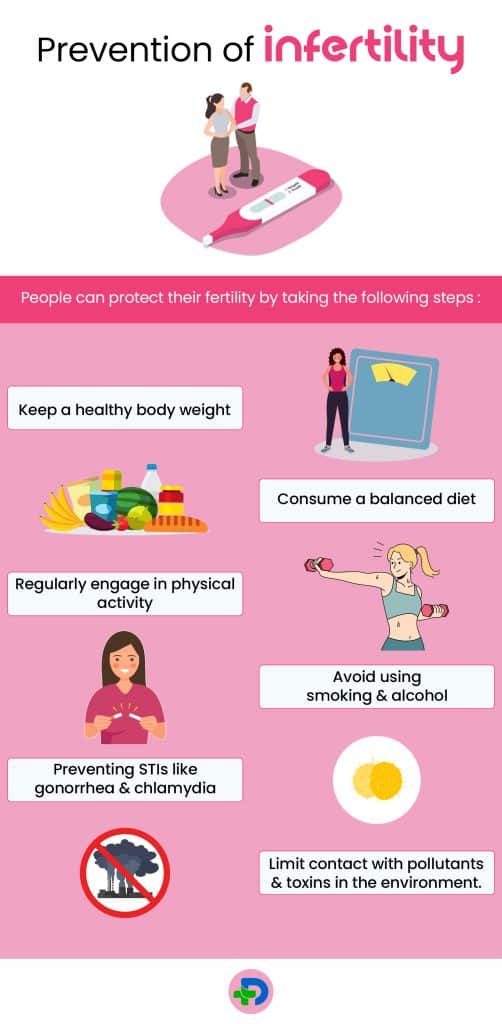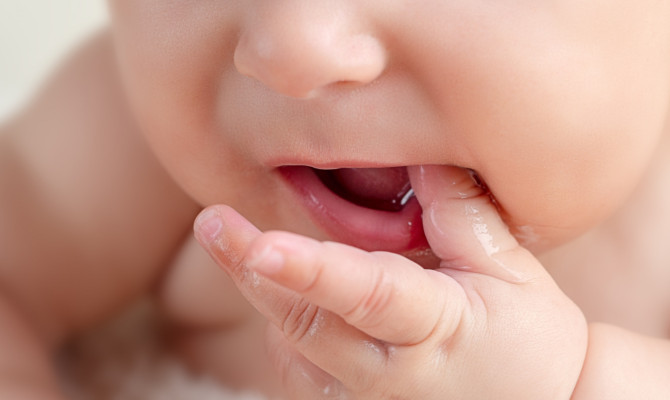Infertility : A General Overview

- Infertility
- 16 Aug 2023
Overview
What is Infertility?
Infertility is a condition where people fail to conceive even after an year of unprotected sexual activity. It could result from an issue in the reproductive system of male, or female or both. Anyone can get it, and the likelihood increases with age. Infertility affects one out of every six individuals of sexual maturity worldwide at some point in their lives.1Overview| Researched based study from Who.int This article discusses infertility in both sexes, its causes, types, and treatment.

Types
Types of infertility
Two types of infertility exist
- Primary infertility – couples who have had regular unprotected sex for at least a year.
- Secondary infertility – couples who have previously been able to get pregnant but are currently unable to.2Types| Researched based study from Medlineplus.gov
Causes
Causes of infertility
Some of the reasons for infertility may include
In women
- Ovulation disorders – when the ovary has trouble releasing eggs, this prevents sperm from fertilizing the eggs.3Causes| Researched based study from Nlm.nih.gov
- Ovarian disorders – like polycystic ovarian syndrome (PCOS) or other disorders.
- Uterine diseases include benign fibroids, congenital septate uterus, and inflammatory endometriosis.1Causes| Researched based study from Who.int
- Blocked fallopian tubes – due to unsafe abortion, pelvic surgery, postpartum sepsis, or untreated sexually transmitted infections (STIs).
- Endocrine disorders – like thyroid problems, hyperprolactinemia.
In men
- Sperm ejection issues – from blockage of the reproductive system due to trauma or diseases like STIs.
- Hormonal disorders – hormones like testosterone control the generation of sperm. Hypogonadism and cancers may cause hormonal imbalance.
- Absence or low sperm count – testicular failure to make sperm, for example, due to varicoceles or chemotherapy that affect sperm-producing cells.
- Abnormal shape of the sperm and problems with its movement (motility) –using anabolic steroids can result in aberrant sperm characteristics such as sperm count and shape.1Causes| Researched based study from Who.int
- Unknown cause – an individual is still infertile despite the semen parameters being normal.4Causes| Researched based study from Nlm.nih.gov
Symptoms
Symptoms of infertility
Inability to get pregnant is the important sign of infertility.
Female infertility symptoms could include:
- Irregular or absent period.
- Too much pain during a period.
- Lack of sex drive.
- Overgrowth of facial hair.
Men’s infertility symptoms could include the following:
- Changes in hair growth.
- Diminished or a lack of sexual arousal.
- Testicular pain, a bump, or swelling.
- Issues with ejaculation and getting erections.
- Undescended testicles.
Risk factors
Risk factors associated with infertility
These factors may cause an individual’s infertility:
- Chromosomal abnormalities – like Fragile X Syndrome, Fanconi Anemia, Klinefelter Syndrome, Noonan Syndrome, etc.5Risk factors| Researched based study from Nlm.nih.gov
- Genetic disorders like sickle cell anemia, cystic fibrosis, etc.
- Age – The fertility of an individual decreases with aging. Women above 35 years and men above 40 years are commonly affected.6Risk factors| Researched based study from betterhealth.vic.gov.au
- Chemotherapy – can cause ovarian failure or drastically lower sperm counts.
- Radiation raises the chance of infertility issues if directed toward the reproductive system.
- STIs or sexually transmitted infections – can result in infertility. For instance – chlamydia can harm a woman’s fallopian tubes and inflame a man’s scrotum.
- Obesity – may lower the likelihood of conception in both genders.
- Being underweight – people who consume a very low-calorie or restrictive diet and those who suffer from eating disorders like anorexia or bulimia.
- Smoking – may invalidate the benefits of fertility treatment and vastly raise the chance of infertility in both genders.7Risk factors| Researched based study from Fda.gov
- Alcohol overuse – can lower sperm count and might hinder the effectiveness of treatment also.
- Stress – can impact both male sperm production and female ovulation.
- Exercise – too little and too much exercise can affect a person’s ability to conceive.
- Eating habits – male and female fertility may be impacted by an unhealthy diet or an eating disorder causing significant weight loss.
- Narcotics – consuming drugs like cocaine or cannabis can reduce fertility in both males and females.
- Environmental factors – male and female fertility issues have been associated with certain herbicides, insecticides, solvents, and metals like lead.
- High heat exposure to the testicles in men – from tight clothes, frequent usage of hot baths, and holding laptops, mobile phones, or heated pads on or near the testes.
- Chronic medical disorders – cancer, diabetes, kidney disease, and circulation issues.
Diagnosis
Diagnosis of infertility
The doctor tries to learn about a patient’s sexual behaviors before infertility testing and may offer suggestions to increase the patient’s chances of becoming pregnant.
Testing for infertility in women may involve
- Pelvic examination – will be done by the doctor to look for structural issues or illness signs.
- Ovulation testing – a hormonal blood test done to determine if a person is ovulating.8Diagnosis| Researched based study from Mayoclinic.org
- Ovarian reserve testing – shows how many eggs are remaining for ovulation.
- Another hormone testing – monitors the levels of pituitary hormones that regulate reproductive activities and ovulatory hormones.
Imaging tests
- Pelvic ultrasound – scans for ovarian or uterine illness.
- Sono hysterogram or a saline infusion sonogram – reveals characteristics inside the uterus that are not visible on a standard ultrasound.
- Hysterosalpingography – is a contrast X-ray imaging technique that assesses the health of the fallopian tubes and uterus and searches for obstructions or other issues.
Rarely, some individuals may need the following
- Hysteroscopy – to check the uterus for any abnormalities.
- Laparoscopy – identifies endometriosis, scarring, obstructions, or abnormalities of fallopian tubes, ovaries, and uterus.
Men may undergo infertility tests that include
- Physical examination – the doctor inspects the testicles and penis for abnormalities.
- A blood test – to evaluate a person’s thyroid and testosterone levels.
- Genetic test – checks for chromosomal abnormalities that cause infertility.
- Semen analysis – is the process of gathering semen samples and analyzing them for DNA abnormalities, low sperm counts, poor sperm motility, and other factors.9Diagnosis| Researched based study from Medlineplus.gov
- Testicular biopsy – to find problems resulting in infertility or to get samples of sperm for assisted reproductive methods.
Imaging tests
- A scrotal ultrasound – detects varicoceles or other issues with the testicles.10Diagnosis| Researched based study from Clevelandclinic.org
- Vasography – in some circumstances, a vas deferens test may be necessary.
- Brain MRI – some people with pituitary issues might get a brain MRI.11Diagnosis| Researched based study from Rsna.org
Management
Management of infertility
Infertility treatment options include dietary adjustments, medication, surgery, intrauterine insemination, and assisted reproductive technology. 12Management| Researched based study from Cdc.gov Men’s and women’s lifestyles may evolve to include the following:
- Stopping some prescription drugs.
- Reducing or getting rid of dangerous substances.
- Increasing the number of sexual activities.
- Routine exercise
- Improving other elements that could otherwise reduce fertility.
Treatment options for infertile males may include
- Medications – can boost sperm count and quality and raise the chance of getting pregnant.
- Surgery – to restore fertility in cases like sperm obstruction, and treating a varicocele may increase your chances of getting pregnant in general.13Management| Researched based study from Nichd.nih.gov
- Sperm retrieval – used to collect sperm if ejaculation is not happening or when the ejaculate has no sperm.
Infertility treatments for women may include
- Medicines to stimulate ovulation – may be required to control or trigger ovulation in females with ovulation problems.
- Using a home ovulation test to monitor ovulation and having sex while ovulating may help some women get pregnant more successfully.
- Intrauterine insemination (IUI) – healthy sperm are inserted straight into the uterus about the time the ovaries make a few eggs ready to be fertilized.
Surgical methods
- Hysteroscopic surgery – treats people with uterine issues like certain fibroids, uterine septum, intrauterine scar tissue, and endometrial polyps.
- Laparoscopic surgery – for more significant fibroids, pelvic adhesions, and endometriosis.
Assisted reproductive technology (ART)
Any fertility procedure that handles the egg and sperm. There are many types of ART and may include:
- In vitro fertilization (IVF) – happens in a laboratory dish where the egg is fertilized by the sperm. One to three fertilized eggs are placed into the uterus by a caregiver.
- Intracytoplasmic sperm injection (ICSI) – An embryologist gives each egg a single sperm injection and then transfers them into the uterus.
- Intrauterine insemination (IUI) or artificial insemination – sperm is injected into the uterus by a medical professional using a long, thin tube.14Management| Researched based study from Nichd.nih.gov
- Assisted hatching – involves removing an embryo’s outer covering to facilitate its implantation in the lining of the uterus.
- Donor eggs or sperms may be required from anonymous donors who have severe sperm- or egg-related issues.
- Surrogate – for women who lack a functioning uterus or whose pregnancy offers a significant health risk, a surrogate woman’s uterus carries the couple’s embryo to term.
Consequences
Consequences associated with infertility
The following consequences could result from infertility
- Stress.
- Anxiety.
- Depression.
- Strained relationships.
- Financial problems – as treatments are expensive.
Treatment for infertility may lead to the following complications
- Ectopic pregnancy.
- OHSS, or ovarian hyperstimulation syndrome.
- Twin, triplet, and other multiple pregnancies.
- Low birth weight or miscarriage, particularly when several embryos are implanted in the uterus.
- Failed treatment – when a couple cannot have a child despite receiving treatment.
Prevention

Prevention of infertility
People can protect their fertility by taking the following steps:
- Keep a healthy body weight.13Prevention| Researched based study from Nichd.nih.gov
- Consume a balanced diet.
- Regularly engage in physical activity. Exercise in moderation.
- Avoid using drugs, smoking, or consuming alcohol.
- Preventing STIs like gonorrhea and chlamydia may lower the chance of infertility.
- STIs should be treatment as soon as possible to prevent infertility.
- Limit contact with pollutants and toxins in the environment.
- Don’t put off conception until it’s too late.
- Follow fertility preservation measures such as freezing eggs or sperm. 15Prevention| Researched based study from Ucsfhealth.org
- People over the age of 35 should get an evaluation.
- To enhance sperm function, refrain from using lubricants during sex.
Prognosis
Prognosis of infertility
Prognosis varies based on the cause of infertility, the age of the couple, and other variables. A couple’s chances of getting pregnant can frequently be increased by making lifestyle modifications or increasing the frequency and timing of sex. Most couples eventually become pregnant, although some go for assisted reproductive technology. More options than ever exist for couples who struggle with infertility. In most circumstances, infertile individuals and couples are likely to get pregnant.
Any feedback on this article?
 This Articles content was accurate
This Articles content was accurate Very Informative Article
Very Informative Article I have a question or a comment
I have a question or a comment
 This article contains inaccurate content
This article contains inaccurate content This article was not helpful
This article was not helpful I have a question or a comment
I have a question or a comment
We appreciate your helpful feedback!
Checkout our social pages
References
-
World Health Organization
Infertility | Overview
-
Medline Plus
Infertility | Types
-
National Library of Medicine
Female Infertility | Causes
-
National Library of Medicine
Male Infertility | Causes
-
National Library of Medicine
The Genetics of Infertility: Current Status of the Field | Risk Factors
-
Better Health Channel
Age and fertility | Risk Factors
-
U.S FOOD & DRUG ADMINISTRATION
How Smoking Affects Reproductive Health | Risk Factors
-
Mayoclinic
Infertility | Diagnosis
-
Medline Plus
Semen Analysis | Diagnosis
-
Cleveland Clinic
Infertility | Diagnosis
-
Radio Graphics
Role of Imaging in the Evaluation of Male Infertility | Diagnosis
-
Centers for Disease Control and Prevention
Infertility FAQs | Management
-
The Eunice Kennedy Shriver National Institute of Child Health and Human Development
Fertility Treatments for Males | Management
-
The Eunice Kennedy Shriver National Institute of Child Health and Human Development
Assisted Reproductive Technology (ART) | Management
-
The Regents of The University of California
Reducing Your Risk of Infertility | Prevention

































